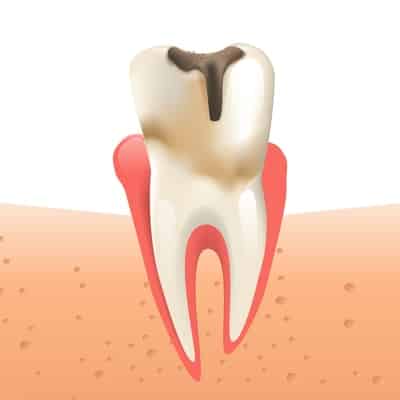
From when we are very young, we are told to brush our teeth twice a day, control our sugar intake and floss regularly – otherwise, we will get cavities. But what is a cavity? And is the drill-and-fill method the only way of treating dental caries?
Actually tooth decay – or dental caries – is a consequence of bacterial activity on the surfaces of our teeth. Our mouth is home to millions of bacterial species, both “good” and “bad”. A particularly sugary diet feeds the bacteria that produce acid, and this in turn promotes dental caries.
Dental decay is caused by several factors, including but not limited to:
- Repeated intake of sweet sticky foods especially in between mealtimes
- Inadequate removal of plaque – not brushing or flossing efficiently
- Decreased defence factors such as inadequate saliva (dry mouth)
- Old fillings with leaky margins.
All of these factors will initiate the process of tooth decay, which occurs in several stages.
Stage 1: The initial lesion
The earliest form of a cavity arises as a white spot lesion or a brown spot lesion. This is where mineral is removed from the tooth surface at the microscopic level. The tooth still feels hard to touch and often there are no symptoms. The cavity is not yet visible on X-rays.
At this stage, early intervention with topical fluoride or specialised products can restore minerals back into the tooth structure and thus prevent the lesion from getting any further. This is termed remineralisation, or arresting of dental caries.
Stage 2: Dentine caries
If the initial lesion is not reversed, the bacteria continue to tunnel their way through the tooth until they reach the inner dentine layer.
The dentine layer of teeth contains a direct link to the nerve of the tooth and now the tooth may become sensitive to cold or sweetness. Sometimes, though, the cavity can present with no symptoms until very late. The cavity would also be visible on X-rays, and clinically may have a shadowy appearance.
Unfortunately, once dental caries is in the dentine zone, remineralisation is not possible and a filling will be required. Depending on the size and depth of the cavity, several material options are available for this.
Stage 3: Caries involving pulp
If left long enough, the cavity can invade the nerve chamber of the tooth – the pulp. When caught quickly enough, we can prevent nerve death by placing a medicament over the pulp and overlying that with a filling.
However, if left too late dental caries can cause nerve damage and ultimately death of the nerve and loss of blood supply to the tooth. When this happens, the tooth will need root canal treatment (a filling in the nerve chamber) in order to be restored.
While some teeth show symptoms ranging from mild sensitivity to a throbbing, dull ache, a large percentage of teeth will undergo nerve death without any symptoms!
In summary, along with good oral hygiene and diet, it is important for us to have regular checkups and up-to-date X-rays. In this way we are able to catch any cavities in the early stages, where remineralisation is still possible. In this age of minimal-intervention dentistry, prevention of dental caries is a priority.

